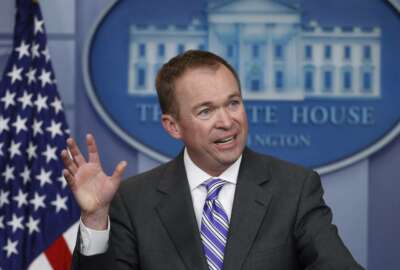
No word yet on feds’ pay in president’s 2018 budget blueprint
President Donald Trump offered a first look at his upcoming management agenda in the 2018 budget blueprint. The agenda will focus on eliminating agency reporting...
Federal employees will have to wait a little while longer for word on whether they’re getting a pay raise in 2018.
President Donald Trump’s budget blueprint, which he released Thursday morning, makes no mention of federal employees’ pay and benefits.
Title 5 of the U.S. Code sets the annual pay adjustment formula for most federal employees. The President can ultimately choose to differ from that formula and has often indicated his plans in the annual budget request to raise — or freeze — civilian and military employee pay.
Congress can weigh in and suggest a different pay adjustment in its budget. Some members of Congress have introduced their own legislation suggesting alternative pay raises, but none have been adopted in recent years. Rep. Gerry Connolly (D-Va.) and Sen. Brian Schatz (D-Hawaii) recently introduced legislation that would give federal employees a 3.2 percent raise in 2018.
A more detailed budget plan with more policy initiatives should be out sometime in May, which may include more details about federal pay and benefits.
Ultimately, the President is giving agency heads the discretion to implement lower discretionary budgets over the next two years than compared to previous administrations. And those top-line numbers, along with the President’s reorganization efforts, will drive future cuts to the federal workforce.
The budget does not describe specific workforce reductions. It doesn’t detail how many positions or people the White House hopes to cut.
But the size and scope of the cuts has many federal employee unions and associations worried.
“The severity of the budget cuts proposed by President Trump could require mass layoffs of employees at federal departments and agencies, although the budget blueprint released by the White House does not detail how many federal employees could lose their jobs,” American Federation of Government Employees National President J. David Cox said in a statement.
The budget also has the National Treasury Employees Union concerned about the impact deep civilian agency cuts could have in the future.
“This is an unwarranted attack on the federal workforce,” NTEU President Tony Reardon said. “Federal employees are nonpartisan. They work on the priorities set by the administration that is in office and carry out the laws passed by Congress. Rest assured they will carry on and do their jobs admirably, as always, but I worry about the long-term effects that such an austere budget proposal will have.”
Trump’s temporary hiring freeze and forthcoming plan from the Office of Management and Budget to cut the workforce through attrition, as well as agencies’ preparations for governmentwide reorganization, will be the stepping stones to future workforce changes.
“These two actions are complementary and plans should reflect both Presidential actions,” the budget plan said. “Legislation will be required before major reorganization of the Executive Branch can take place, but the White House is best situated to review and recommend changes to the Congress.”
The budget also proposes to eliminate funding for 19 independent agencies:
- African Development Foundation
- Appalachian Regional Commission
- Chemical Safety Board
- Corporation for National and Community Service
- Corporation for Public Broadcasting
- Delta Regional Authority
- Denali Commission
- Institute of Museum and Library Services
- Inter-American Foundation
- U.S. Trade and Development Agency
- Legal Services Corporation
- National Endowment for the Arts
- National Endowment for the Humanities
- Neighborhood Reinvestment Corporation
- Northern Border Regional Commission
- Overseas Private Investment Corporation
- United States Institute of Peace
- United States Interagency Council on Homelessness
- Woodrow Wilson International Center for Scholars
Some of these agencies have been on the chopping block before in previous government reorganization proposals and suggestions. Though the budget makes it clear funding for these agencies will disappear, it does not detail whether their functions will disappear entirely or get absorbed into other departments.
President’s Management Agenda
For the first time, the budget suggests what Trump’s management agenda may look like. It described four general priorities the administration wants to see progress on by 2020.
Specifically, it stresses an evidence-based approach to agency management and using “real, hard data to identify poorly performing organizations and programs.”
The administration will hold agencies accountable to reporting and then meeting critical performance standards.
The budget also takes a stance on previous administration’s efforts, particularly on IT, human capital, acquisition, financial management and real property. Past reporting requirements on these initiatives kept managers from tackling more critical work, the budget said.
“The administration will roll back low value activities and let managers manage, while holding them accountable for finding ways to reduce the cost of agency operations,” it said. “As part of this effort OMB will review requirements placed on agencies and identify areas to reduce obsolete, low-value requirements.”
The budget also emphasizes the role agencies play in delivering key services to the public. This is by no means a new concept; the Obama administration also emphasized customer service in recent years. But the President’s approach outlined in the budget is direct, describing cumbersome acquisition processes and long time-to-hires.
“The administration will use available data to develop targeted solutions to problems federal managers face and begin fixing them directly by sharing and adopting leading practices from the private and public sectors,” the proposal said.
How agencies buy products and service, hire top talent and use technology will be key areas of focus.
Copyright © 2025 Federal News Network. All rights reserved. This website is not intended for users located within the European Economic Area.
Nicole Ogrysko is a reporter for Federal News Network focusing on the federal workforce and federal pay and benefits.
Follow @nogryskoWFED





